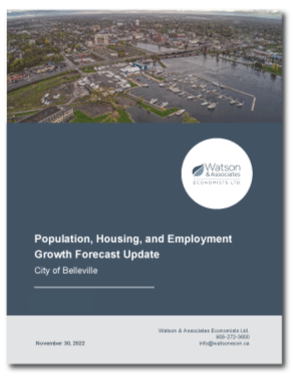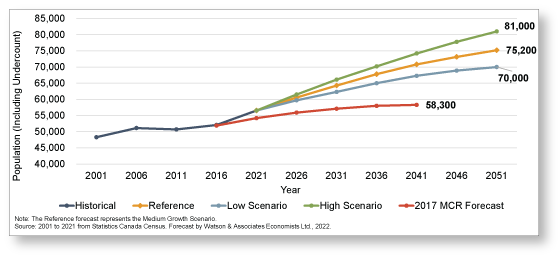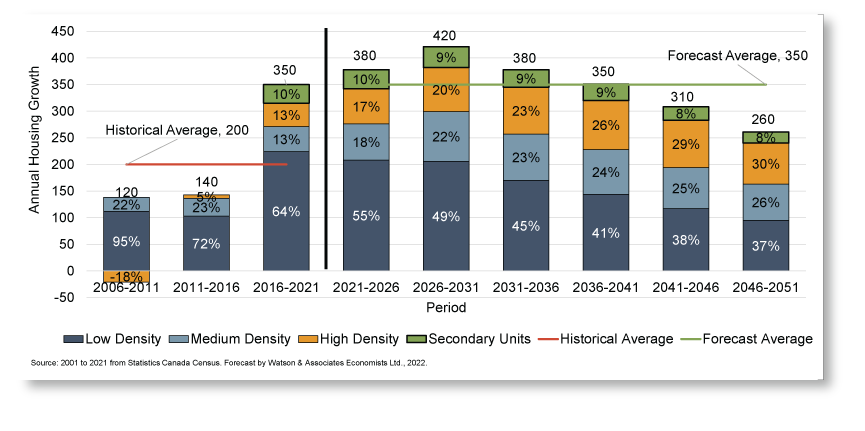Growth Management
The City of Belleville has experienced rapid growth over the recent years. Understanding the city's anticipated growth needs is made easier by the revised Growth Forecast until 2051.
 Growth Forecasts to 2051
Growth Forecasts to 2051
The City of Belleville retained Watson & Associates Economists Ltd. (Watson) in the summer of 2022 to undertake an updated assessment of the City’s long-term population, housing, and employment growth potential to the year 2051. Since the release of the City’s 2019 Comprehensive Review (C.R.), several key factors have contributed to the need to review the long-term growth potential for the City.
Full details of the Population, Housing, and Employment Growth Forecast Update can be found in the link below.
The growth of the City is guided by the policies within the Official Plan and the Loyalist West Secondary Plan.
|
|
Growth will be accommodated through efficient use of existing serviced land, the logical extension or improvement of services, and appropriate infilling. In preparing for growth, careful planning and decision-making will ensure the unique and desirable characteristics of the City are not lost in accommodating growth pressures, including the importance of 5 year capital planning to address current infrastructure deficiencies and developing asset management strategies and programs to resolve delivery shortfalls. The urban service area will be the focus of the majority of future residential growth and non-residential development. In the rural areas, the Hamlets of Foxboro, Plainfield, Latta, Roslin, Halloway, and Point Anne will continue to function as local service centres and the focus of growth in the rural area. Employment opportunities will be provided through a balance of manufacturing, research and development, education, agriculture, tourism, and commercial and industrial uses in areas designated and determined to be best suited for each economic sector. Due in part to the fact that the City of Belleville includes the largest urban area in the Quinte region, the City will continue to be the centre of economic activity and employment opportunities. The City seeks to manage growth and development in a sustainable manner. Sustainable development recognizes the interdependence of the economic, environmental and cultural needs of the community. It promotes actions that expand economic opportunity, improve environmental quality, increase social well-being, and expands cultural engagement. |
|
Long-Term Population Forecast Scenarios, 2021 to 2051
The chart graphically compares the High, Medium and Low Population Growth Scenarios for Belleville. The 2019 Municipal Comprehensive Review (M.C.R.) forecast is also displayed, demonstrating that all growth scenarios exceed the previously established long-term population growth outlook for the City. As highlighted, the City’s population outlook at 2051 ranges from 70,000 to 81,000 residents. The Medium (Reference) growth scenario has been determined to represent the “most likely” long-term population growth outcome for Belleville. |
|
Five-Year Incremental Housing Growth – Historical and Forecast, 2006 to 2051
The chart summarizes the City’s household forecast from 2021 to 2051 in five-year growth increments and by structure type. Housing trends between 2001 and 2021 are also provided for historical context. |
|
Historical and Forecast Employment Forecast, 2001 to 2051
Three long-term employment growth scenarios have been developed for the City over the 2021 to 2051 forecast period, as shown above. The 2019 M.C.R. Growth Forecast is also provided for context. As previously discussed, the long-term economic outlook for the City and the surrounding commuter-shed is positive, which supports a steady increase in local employment across a range of industrial, commercial and institutional sectors. While total employment in Belleville between 2016 and 2021 declined, due in part to the COVID-19 pandemic, regional employment conditions have sharply rebounded since 2021 and economic growth is expected to continue to strengthen through to 2026 and beyond. |
Supporting Growth Through Infrastructure
Growth is impacted by infrastructure, which contributes to economic growth and employment. The City of Belleville is undertaking initiatives to support and sustain growth in the city. See some of our initiatives below.
| Loyalist West Secondary Plan |
|
To facilitate and accommodate up to 28,000 people, the City is updating the Loyalist West Belleville Secondary Plan. |
| Avonlough Sewage Pumping Station |
|
To service development of up to 4200 residential dwelling units in the Loyalist West Belleville Secondary Plan area, the city will be designing and constructing the Avonlough Sewage Pumping Station. |
| Northeast Industrial Park Environmental Assessment |
|
To accommodate industrial growth, the City is undertaking an environmental assessment to provide road access and municipal servicing to more than 685 acres of City-owned lands in the Northeast Industrial Park.
|
|
Bell Boulevard and North Front Street Corridor Study |
|
To facilitate the intensification of a commercial corridor as a potential mixed-use development area, the City is undertaking the Bell Boulevard and North Front Street Corridor Study. |
|
Infrastructure Phasing Strategy |
|
To rehabilitate and renew older areas the city has recently identified opportunities and constraints based upon past engineering studies through the Infrastructure Phasing Strategy. |
|
Development Change Projects |
|
The City’s Asset Management Plan will be used in preparing a 10-year capital plan to plan for implementation of required infrastructure upgrades and extensions. Many of these projects are further developed through our Development Charges projects.
Growth related to projects like subdivision developments are paid through development charges (Growth pays for Growth). |





